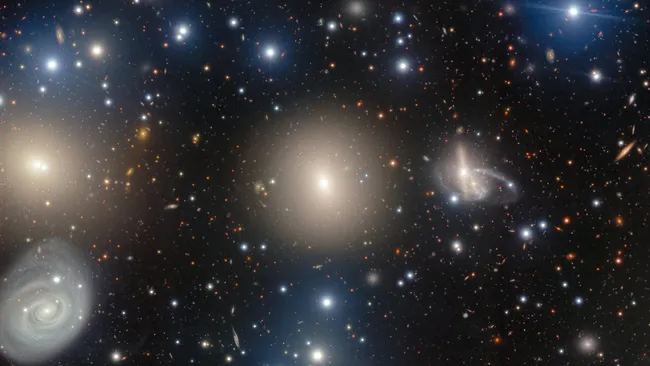Science: This view of cosmic chaos shows a portion of the giant Perseus galaxy cluster, which includes several giant elliptical galaxies, a dusty spiral whose arms are fading, and several edge-on galaxies, some of which appear to be experiencing interactions or mergers with their neighbors. And that’s just a small portion of the galaxy cluster, which lies between 240 and 250 million light-years from Earth and contains thousands of galaxies.
The giant elliptical galaxy at the center of the image, taken by the Gemini North telescope on Mauna Kea in Hawaii, is NGC 1270. The galaxy has long ago given up on new star formation; NGC 1270 now contains only old, cool, red stars, which give the elliptical galaxy its distinctive color. At its center lurks an active supermassive black hole, with a mass 12 billion times greater than that of our sun.
NGC 1270 is one of the most massive galaxies in the Perseus Cluster, but it doesn’t quite match the stature of another elliptical galaxy in the cluster, namely NGC 1275. Located just outside the field of view of this Gemini North image, NGC 1275 is called the Brightest Cluster Galaxy, or BCG. It’s a true giant at the center of the Perseus Cluster and it’s still growing, with 13 billion solar masses of hydrogen gas falling onto it from the cluster’s atmosphere. In fact, computer simulations show that up to 70% of the mass of the BCG – and others like it in all clusters – comes from material that has been caught in their cluster’s gravitational trap and fallen toward the center of the cluster, where it collects on the BCG. NGC 1275 lies at the very center of the cluster’s mass. It’s the center around which all this galactic chaos unfolds. Surrounding it is a hazy halo of diffuse light produced by stars that get ejected from galaxies falling into the cluster by gravitational tides flowing into the environment. It’s not just individual stars that get ejected; the European Space Agency’s Euclid spacecraft recently detected 70,000 free-floating globular clusters within the cluster’s central 1.6 million light-years.
This diffuse halo of light is called intra-cluster light, or ICL. Although the ICL and BCG have somewhat similar origins, with most of their mass coming from material ejected from other galaxies falling into the cluster, they are not connected. The center of the ICL is about 200,000 light-years from the center of NGC 1275, meaning that the BCG and ICL are distinct but overlapping. Stars in the ICL follow different paths to the stars in NGC 1275 and have different amounts of heavy elements. Dwarf galaxies are thought to be the source of the stars that collectively form the ICL, but there are too few dwarf galaxies in the Perseus cluster—Euclid counted about 1,100—to explain the ICL’s brightness and extent. Instead, slightly more massive galaxies are probably the source.
